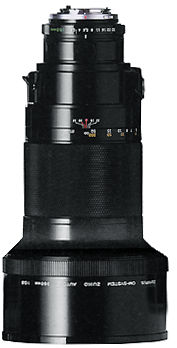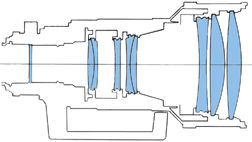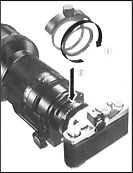Among the three high speed white-bodied Zuiko tele-lenses, the longest focal length is the Zuiko AUTO-T 350mm f/2.8 ED-IF. The lense shares many optical and physical characteristics with the other two Zuiko equivalent in Zuiko AUTO-T 180mm f/2.0 ED-IF and Zuiko AUTO-T 250mm f/2.0 ED-IF. As address earlier, these lenses are easily rank brightest in their class and has made the OM system more appealing to professional photographers.
 <<< -- Credit: Image was scanned from a OM-4 Sales Manual. |
Zuiko AUTO-T 350mm f/2.8 ED-IF |
As per my personal assumption why Olympus has chosen the odd focal length for their new breed super-telephoto lenses earlier, (read: Zuiko 250mm f/2.0 EDIF section); this USD5,500-00 Zuiko blockbuster Zuiko Super-tele-lense carries a more significant reason to support my theory as simply, there are no alternative and/or equivalent optic to compare its pricing and even performance. But to a photographer who is also smart in financial investment, the good choice of lense speed and focal length mid between the two super telephotographic range of 300mm and 400mm has made the price seemingly very reasonable if others are available for price/performance evaluation. It only takes a seasoned photographer who has owned a similar lense type to appreciate its true value offers. As most often, even if 300mm focal length, a 6.5X long reach as compared to a standard 50mm lense is good enough for a great varieties of photographic topics, but sometimes you will wish you have another 100mm more in focal length extension while on the other hand, those who has the 400mm would wish he can have another f-stop extra to use for struggling against slow shutter speed in super-telephotography. Thus, the good combination of lense speed and focal length is designed as a compromise for someone who often work at locations. With a compatible Teleconverter(s): 1.4X-A this lens may be transformed into a 500mm f/4.0 ED-IF super -telephoto lense !
 |
With its superb image-forming ability and excellent lens handling design, for sports and news photos as well as for shooting wildlife, or in stage fashion and/or shooting inaccessible subjects or events, this lense will heighten picture-taking possibilities even in unfavorable conditions. |
The use of ED glass for this kind of long focal length is a good move. As natural light consists of a mix of wavelengths spanning the spectrum from infrared to ultraviolet. The light that has passed through a Ions is dispersed, with the different wavelengths coming to focus at different distances from the lens. This phenomenon is increasingly pronounced as the focal length becomes greater, resulting in color shift and blurred images. The 350 mm lense uses a specially developed optical glass which possesses a low refractive index and low dispersion characteristics to keep chromatic aberration inherent to the super telephoto lenses to absolute minimal level.
 |
|
This Zuiko lense incorporates a rotating cam (internal focus) for silky smooth and responsive focusing to capture any picture-taking opportunities. The internal focusing design also enables him to shoot at close distances down to 3 m (10 ft.) and at such distance, an impressive reproduction ratio 1: 7 can be achieved. |
Note: Olympus has warned the front element of the lense uses a special material less hard than the conventional lenses, so that greater care should be taken to protect it from scratching. When not taking pictures, be sure to put the front lense cap on. Filter Replacement and Filter Holder: A NEUTRAL 46 mm rear filter comes with the lense as standard accessory. The filter is a part of the lense optical system, so that be careful to always use the neutral filter when any other filter is not used. After replacing the filter, focus adjustment is necessary.
Specifications:
Current version: Zuiko AUTO-T
350mm f/2.8 ED-IF
Optical Construction: 9 elements in 7 groups
(multicoated)
Diaphragm: Automatic
 |
Angles of view: Diagonal: 7° |
Lens Hood: Built-in retractable
design, extend
or retract the lens hood by rotating it.
Maximum diameter: 142mm
Filter attachment size/Filters: 46mm REAR slip-in type
 |
Tripod Mount: A self-contained tripod mount allows free rotation. Tighten the tripod screw firmly into the tapped hole of the tripod mount. It can be locked in a desired position (horizontal. vertical, etc.) with the clamping knob. There are four holes on the tripod mount. A carrying strap lug is provided at the side of the lense for easy carrying and a leatherette soft lense pouch is supplied as standard accessory. |
Recommended Focusing Screens: 1-1*, 1-4*, 1-6#. 1-7#. 1-10*, 1-13* and 1-14*. * Compatible. # The 1-6 or 1-7 (microprism-clear field type) offers a brighter image. but the meter built into the OM-1 and OM-2 (on MANUAL) does not give correct light readings. With the OM-2 on AUTO, correct exposures are made on the film, but the meter needle does not give correct light readings.
### More
info on "Picture Angle" or make use of the Glossary
section in PIM site..
| previous | The
F-Zuiko AUTO-T 300mm f/4.5
| NEXT | 2/2 The real super telephoto range starts from 400mm - E-Zuiko AUTO-T 400mm f/6.3
ZUIKO Telephoto
lenses | 85mm | 100mm | 135mm | 180mm | 200mm | 250mm | 300mm | 350mm | 400mm | 500mm REFLEX | 600mm | 1000mm
A
Brief overview on Zuiko Optics
Zuiko Fisheye Lenses 8mm f/2.8 Circular Fisheye | 16mm
f/3.5
Full Frame Fisheye
Zuiko Ultra-Wideangle Lenses 18mm f/3.5 | 21mm f/2.0 | 21mm f/3.5 | 24mm f/2.0 | 24mm f/2.8
Zuiko Wideangle Lenses 28mm f/2.0 | 28mm f/2.8 | 28mm f/3.5 | 35mm f/2 | 35mm f/2.8 |
Zuiko Standard Lenses 40mm f/2.0 | 55mm f/1.2 | 50mm f/1.2 | 50mm f/1.4 | 50mm f/1.8 | Zuiko 50mm f/2.0 PF
Zuiko Medium-Telephoto Lenses 85mm f/2.0 | 100mm f/2.0 | 100mm f/2.8 | 135mm f/2.8 | 135mm f/3.5
Zuiko Telephoto Lenses 180mm f/2.0 EDIF | 180mm f/2.8 | 200mm f/4.0 | 200mm f/5.0 Auto-T (brief)
Zuiko Super-Telephoto Lenses 250mm f/2.0 EDIF | 300mm f/4.5 | 350mm f/2.8 EDIF | 400mm f/6.3
|
500mm | 600mm f/6.5 |1000mm f/11.0
Special application Zuiko optics: 24mm f/3.5 Shift | 35mm f/2.8 Shift | 500mm f/8 Reflex | AF Zoom 35-70mm
f/4.0
| Zuiko
50mm f/2.0 PF
Tele-Converters: 1.4X-A / 2X-A
Zuiko
Macro/Close focus lenses: Zuiko
AUTO MACRO 20mm f/3.5
| Zuiko
AUTO MACRO 20mm f/2.0
| Zuiko
AUTO MACRO 38mm f/3.5
| Zuiko
AUTO MACRO 38mm f/2.8
| Zuiko
AUTO MACRO 50mm f/3.5
| Zuiko
AUTO MACRO 50mm f/2.0
| Zuiko
AUTO MACRO 1:1 80mm f/4.0
| Zuiko
AUTO MACRO 90mm f/2.0
| Zuiko
AUTO MACRO 135mm f/4.5
Zuiko AUTO-Zoom Lenses
- Main
Index page
| S-Zuiko AUTO Zoom 28-48mm f/4.0 | Zuiko AUTO Zoom 35-70mm f/3.6 | S-Zuiko AUTO Zoom 35-70mm f/4.0 | Zuiko AF AUTO Zoom 35-70mm f/4.0 | S-Zuiko AUTO Zoom 35-70mm f/3.5
~ f/4.5
|
S-Zuiko
AUTO Zoom 35-70mm f/3.5 ~ f/4.8
| Zuiko
AUTO Zoom 35-80mm f/2.8 ED
| Zuiko AUTO Zoom 35-105mm f/3.5
~ f/4.5
| Zuiko
AUTO zoom 50-250mm f/5.0
| Zuiko AUTO zoom 65-200mm f/4.0 | S-Zuiko AUTO zoom 70-210mm f/4.5 ~ f/5.6 | Zuiko AUTO Zoom 75-150mm f/4.0 | Zuiko AUTO Zoom 85-200mm f/4.0 |
Zuiko
AUTO Zoom 85-250mm f/5.0
|
S-Zuiko
AUTO Zoom 100-200mm f/5.0
|
| Back | Index Page of OM Zuiko lenses
| Back | to Main Index Page of OM1(n) & OM2(n)
Series SLRs
| Message Board | for
your favourite Olympus
OM-1(n)
and OM-2(n)
series models
| Message Board |
for your
Zuiko Optics in a shared environment
| Message Board | Specifically for Dispose or Looking for OM Photographic
Equipment
About this photographic site.
Home - Photography in Malaysia |
Copyright
© 2000.
leofoo ®. MIR Web Development Team.
Maintainers
for OM Zuiko Site & Message Board:
Rick
Oleson (Email: rick_oleson@yahoo.com Website:
http://rick_oleson.tripod.com), Bruce Hamm
(bhamm@magma.ca), John Orrell
(john@orrellj.freeserve.co.uk), Simon Evans,
(http://www.mawddwy.freeserve.co.uk); Shaun
(shaun@noemail.com), Andy Radcliffe
(AndyJRadcliffe@manx.net)
Special
thanks to:
Gregory
P. Logiodice, Bob Gries, Erwin Voogt, Joel Wilcox, Rick
Oleson, Simon Evan and many others for granting permissions to use their images
of either lenses, cameras and own pictures appeared in this Zuiko website.
Credit: My old time buddy,
Ahmad
Ikram,
Dr of Rubber Research Institute (RRI), Malaysia
who shares the same passion with me and also lending his OM-1n, OM-4 and the Motor
Drive 1 to me for preparing some images in this site; Mark Dapoz <md@dementia.org>for reminding
some broken links; Mr Poon of Foto Poon, Ipoh, Mr Richard, Ampang Park,
Mr Lim and Miss Jenny of Foto Edar for their generosity for
their OM1(n), OM2n camera and some Zuiko lenses. Mr Hans van Veluwen for
mistakenly using some content earlier from his OM website; J Sorensen
for providing some useful images to rectify some technical "flaws"; Mr
Gen Holst for helping during the early stages of development of this OM site;
Mr KKLow for some of his earlier images on the OM-1appeared in this website;
Miss Wati and Mirza for helping me
to convert this Operation Manual into a HTML format. Mr MCLau for rectifying
some mistakes made on the earlier preview sites. A personal tribute to the creator
of the OM system and also a site dedicated to all the fans of Olympuses and Zuiko
Optics worldwide. Some of the content and images appeared in this site were scanned
from OM official marketing leaflets, brochures and instruction manual(s) for educational
purposes. Olympus is a registered trade name of Olympus Optical Inc., Japan. Site
created 'unfortunately again with an IMac.
